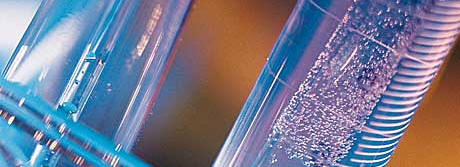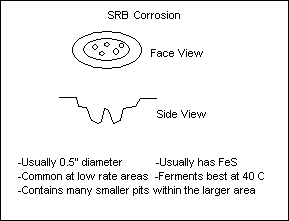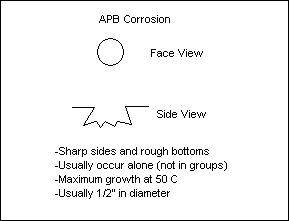
|
Eugene Dakin Ph.D., P.Chem Professional Chemist |
|
|
|
|
Microbial Induced Corrosion Microbial induced corrosion (MIC) occurs when corrosion exists due to microorganisms.
The two most commonly tested groups of microorganisms are SRB's and APB's.
SRB is the acronym for Sulphate Reducing Bacteria. Formations that have natural occurring sulphate form corrosive Hydrogen Sulphide (H2S) with the aid of SRB's. Corrosive H2S then reacts (corrodes) with iron to form iron sulphide. SRB's are removed by a wide variety of available biocides. The best biocides are those that are also corrosion inhibitors (leave a protective film).
One of the waste products of SRB's is Hydrogen Sulphide (H2S). This toxic and corrosive chemical reacts with metallic iron (Fe) to form the potentially explosive product called Iron Sulphide (FeS). Iron is removed from the pipeline wall molecule-by-molecule until a pit eventually perforates the wall and forms a hole.
APB is the acronym for Acid Producing Bacteria. Almost all acids are corrosive to metals. By controlling the population of these bacteria, the concentration of aggressive acids are lowered.
MIC is best controlled with a combined batching and pigging program. Other variations include batching only, and various types of pigging.
The presence of APB's and SRB's are determined by convenient tests that are inoculated at the site.
Most MIC is induced by symbiotic means. Symbiosis is mutually dependent situations. For example: Most yeasts found in oilfield lines are Slime Formers (they form a layer between the pipeline fluids and the pipeline wall). SRB populations lower significantly decrease at very low pH values. SRB's proliferate in between the layer of yeast and the pipeline wall. SRB's then excrete nutrients that the yeast metabolizes to increase its growth rate, which provides a larger protective layer for the SRB's...and so on.
Identification of SRB's and APB's are subcategorized as Sessile and Planktonic. Sessile microbes are those attached to linings and pipe surfaces, where Planktonic microbes are floating in the liquid.
MIC is usually controlled with biocides that have been batched and pigged.
|
|
| © 2006 - Eugene Dakin -
|


